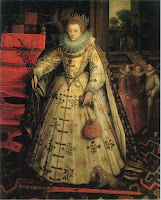 |
| 'The Ditchley Portrait', by Marcus Gheeraerts the Younger, c. 1592 The queen stands upon England depicted on top of a globe. Public domain. |
The 'second reign'
The fifteen years between the defeat of the Armada and Elizabeth's death was a troubled period, and we should not be deceived by the dazzling images of the Queen produced in the 1590s.The Armada was a disaster for Spain but not a knock-out blow. In 1589 Drake headed a counter-attack, descending on Lisbon in order to put a pretender on the Portuguese throne and intercept the treasure fleet from the Indies, but this was an ignominious failure. The war with Spain dragged on.
From the point of view of Spain, Ireland was England’s greatest area of vulnerability. It was governed by a thinly-spread English colonial class headed by a Lord Deputy and it remained stubbornly Catholic. English attitudes to the Irish were profoundly racist - shown, for example in Edmund Spenser's A View of the Present State of Ireland.
The new men
On a personal level, the death of Leicester in September 1588 was a grievous blow to Elizabeth. In November it was observed that she was ‘much aged and spent and very melancholy’. Leicester’s death was the first of several events which steadily transformed the membership and profile of the Elizabethan establishment. Walsingham died in April 1590, his last years having been spent in comparative poverty because of the debts of his late son-in-law, Philip Sidney. The debt-ridden Lord Chancellor Hatton died from kidney disease in November 1591.Sir Walter Raleigh seemed likely to become Elizabeth’s third favourite after Leicester and Hatton. She granted him most of the offices in the south-west vacated by the death of the second earl of Bedford, as well as lucrative monopolies in the east Midlands and Ireland. But he blotted his copybook, by seducing Elizabeth's maid of honour, Elizabeth Throckmorton, daughter of her first ambassador to Paris. In the summer of 1591 Bess discovered that she was pregnant, and the couple secretly married. In February 1592 she gave birth to a boy, but when the marriage was discovered on 31 May she was sent to the Tower.
Raleigh at this time was on a privateering voyage to the Azores, but in July he was recalled and sent to the Tower. Although both were released in August, when his fleet captured the Madre de Dios, he remained under a cloud for the next five years.
Burghley became more dominant than ever in the Privy Council, and he exploited his position to ensure that the former advocates of a more interventionist foreign policy were replaced by more cautious strategists.
Elizabeth’s last years were dominated by factional conflict. Politicians jockeyed for position, ready for her death. The most deadly feud was between the followers of Essex and those of Robert Cecil.












